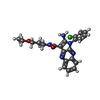[English] 日本語
 Yorodumi
Yorodumi- PDB-4p5q: Human EphA3 Kinase domain in complex with quinoxaline derivatives -
+ Open data
Open data
- Basic information
Basic information
| Entry | Database: PDB / ID: 4p5q | ||||||
|---|---|---|---|---|---|---|---|
| Title | Human EphA3 Kinase domain in complex with quinoxaline derivatives | ||||||
 Components Components | Ephrin type-A receptor 3 | ||||||
 Keywords Keywords | TRANSFERASE / TRANSFERASE INHIBITOR | ||||||
| Function / homology |  Function and homology information Function and homology informationfasciculation of sensory neuron axon / fasciculation of motor neuron axon / transmembrane-ephrin receptor activity / GPI-linked ephrin receptor activity / regulation of epithelial to mesenchymal transition / ephrin receptor activity / negative regulation of endocytosis / EPH-Ephrin signaling / regulation of GTPase activity / regulation of focal adhesion assembly ...fasciculation of sensory neuron axon / fasciculation of motor neuron axon / transmembrane-ephrin receptor activity / GPI-linked ephrin receptor activity / regulation of epithelial to mesenchymal transition / ephrin receptor activity / negative regulation of endocytosis / EPH-Ephrin signaling / regulation of GTPase activity / regulation of focal adhesion assembly / EPHA-mediated growth cone collapse / EPH-ephrin mediated repulsion of cells / ephrin receptor signaling pathway / cellular response to retinoic acid / axon guidance / regulation of microtubule cytoskeleton organization / peptidyl-tyrosine phosphorylation / regulation of actin cytoskeleton organization / positive regulation of protein localization to plasma membrane / positive regulation of neuron projection development / receptor protein-tyrosine kinase / cell migration / actin cytoskeleton / nuclear membrane / early endosome / cell adhesion / dendrite / extracellular region / nucleoplasm / ATP binding / plasma membrane / cytosol Similarity search - Function | ||||||
| Biological species |  Homo sapiens (human) Homo sapiens (human) | ||||||
| Method |  X-RAY DIFFRACTION / X-RAY DIFFRACTION /  SYNCHROTRON / SYNCHROTRON /  MOLECULAR REPLACEMENT / Resolution: 1.35 Å MOLECULAR REPLACEMENT / Resolution: 1.35 Å | ||||||
 Authors Authors | Dong, J. / Caflisch, A. | ||||||
 Citation Citation |  Journal: J.Med.Chem. / Year: 2014 Journal: J.Med.Chem. / Year: 2014Title: Pyrrolo[3,2-b]quinoxaline Derivatives as Types I1/2 and II Eph Tyrosine Kinase Inhibitors: Structure-Based Design, Synthesis, and in Vivo Validation. Authors: Unzue, A. / Dong, J. / Lafleur, K. / Zhao, H. / Frugier, E. / Caflisch, A. / Nevado, C. | ||||||
| History |
|
- Structure visualization
Structure visualization
| Structure viewer | Molecule:  Molmil Molmil Jmol/JSmol Jmol/JSmol |
|---|
- Downloads & links
Downloads & links
- Download
Download
| PDBx/mmCIF format |  4p5q.cif.gz 4p5q.cif.gz | 137.3 KB | Display |  PDBx/mmCIF format PDBx/mmCIF format |
|---|---|---|---|---|
| PDB format |  pdb4p5q.ent.gz pdb4p5q.ent.gz | 103.7 KB | Display |  PDB format PDB format |
| PDBx/mmJSON format |  4p5q.json.gz 4p5q.json.gz | Tree view |  PDBx/mmJSON format PDBx/mmJSON format | |
| Others |  Other downloads Other downloads |
-Validation report
| Summary document |  4p5q_validation.pdf.gz 4p5q_validation.pdf.gz | 702.3 KB | Display |  wwPDB validaton report wwPDB validaton report |
|---|---|---|---|---|
| Full document |  4p5q_full_validation.pdf.gz 4p5q_full_validation.pdf.gz | 706.5 KB | Display | |
| Data in XML |  4p5q_validation.xml.gz 4p5q_validation.xml.gz | 15.8 KB | Display | |
| Data in CIF |  4p5q_validation.cif.gz 4p5q_validation.cif.gz | 23.4 KB | Display | |
| Arichive directory |  https://data.pdbj.org/pub/pdb/validation_reports/p5/4p5q https://data.pdbj.org/pub/pdb/validation_reports/p5/4p5q ftp://data.pdbj.org/pub/pdb/validation_reports/p5/4p5q ftp://data.pdbj.org/pub/pdb/validation_reports/p5/4p5q | HTTPS FTP |
-Related structure data
| Related structure data |  4p4cC  4p5zC  2qobS S: Starting model for refinement C: citing same article ( |
|---|---|
| Similar structure data |
- Links
Links
- Assembly
Assembly
| Deposited unit | 
| ||||||||
|---|---|---|---|---|---|---|---|---|---|
| 1 |
| ||||||||
| Unit cell |
|
- Components
Components
| #1: Protein | Mass: 40458.180 Da / Num. of mol.: 1 / Fragment: Kinase domain, Residues 606-947 Source method: isolated from a genetically manipulated source Source: (gene. exp.)  Homo sapiens (human) / Gene: EPHA3, ETK, ETK1, HEK, TYRO4 / Plasmid: p28-LIC-Thrombin / Production host: Homo sapiens (human) / Gene: EPHA3, ETK, ETK1, HEK, TYRO4 / Plasmid: p28-LIC-Thrombin / Production host:  References: UniProt: P29320, receptor protein-tyrosine kinase |
|---|---|
| #2: Chemical | ChemComp-Q0B / |
| #3: Water | ChemComp-HOH / |
-Experimental details
-Experiment
| Experiment | Method:  X-RAY DIFFRACTION / Number of used crystals: 1 X-RAY DIFFRACTION / Number of used crystals: 1 |
|---|
- Sample preparation
Sample preparation
| Crystal | Density Matthews: 1.87 Å3/Da / Density % sol: 34.22 % |
|---|---|
| Crystal grow | Temperature: 293 K / Method: vapor diffusion, hanging drop / pH: 6.5 Details: 0.1M sodium cacodylate pH 6.5, 0.15M ammonium sulf ate, 22.5% PEG 3350 |
-Data collection
| Diffraction | Mean temperature: 100 K | ||||||||||||||||||||||||
|---|---|---|---|---|---|---|---|---|---|---|---|---|---|---|---|---|---|---|---|---|---|---|---|---|---|
| Diffraction source | Source:  SYNCHROTRON / Site: SYNCHROTRON / Site:  SLS SLS  / Beamline: X06SA / Wavelength: 0.99989 Å / Beamline: X06SA / Wavelength: 0.99989 Å | ||||||||||||||||||||||||
| Detector | Type: PSI PILATUS 6M / Detector: PIXEL / Date: Feb 22, 2013 | ||||||||||||||||||||||||
| Radiation | Protocol: SINGLE WAVELENGTH / Monochromatic (M) / Laue (L): M / Scattering type: x-ray | ||||||||||||||||||||||||
| Radiation wavelength | Wavelength: 0.99989 Å / Relative weight: 1 | ||||||||||||||||||||||||
| Reflection | Resolution: 1.35→47.48 Å / Num. obs: 64017 / % possible obs: 97.1 % / Redundancy: 4.1 % / Rmerge(I) obs: 0.049 / Rpim(I) all: 0.028 / Net I/σ(I): 15.9 / Num. measured all: 261570 | ||||||||||||||||||||||||
| Reflection shell | Diffraction-ID: 1 / Rejects: _
|
- Processing
Processing
| Software |
| |||||||||||||||||||||||||||||||||||||||||||||||||||||||||||||||||||||||||||||||||||||||||||||||||||||||||
|---|---|---|---|---|---|---|---|---|---|---|---|---|---|---|---|---|---|---|---|---|---|---|---|---|---|---|---|---|---|---|---|---|---|---|---|---|---|---|---|---|---|---|---|---|---|---|---|---|---|---|---|---|---|---|---|---|---|---|---|---|---|---|---|---|---|---|---|---|---|---|---|---|---|---|---|---|---|---|---|---|---|---|---|---|---|---|---|---|---|---|---|---|---|---|---|---|---|---|---|---|---|---|---|---|---|---|
| Refinement | Method to determine structure:  MOLECULAR REPLACEMENT MOLECULAR REPLACEMENTStarting model: 2QOB Resolution: 1.35→39.189 Å / SU ML: 0.11 / Cross valid method: FREE R-VALUE / σ(F): 1.89 / Phase error: 17.44 / Stereochemistry target values: ML
| |||||||||||||||||||||||||||||||||||||||||||||||||||||||||||||||||||||||||||||||||||||||||||||||||||||||||
| Solvent computation | Shrinkage radii: 0.9 Å / VDW probe radii: 1.11 Å / Solvent model: FLAT BULK SOLVENT MODEL | |||||||||||||||||||||||||||||||||||||||||||||||||||||||||||||||||||||||||||||||||||||||||||||||||||||||||
| Refinement step | Cycle: LAST / Resolution: 1.35→39.189 Å
| |||||||||||||||||||||||||||||||||||||||||||||||||||||||||||||||||||||||||||||||||||||||||||||||||||||||||
| Refine LS restraints |
| |||||||||||||||||||||||||||||||||||||||||||||||||||||||||||||||||||||||||||||||||||||||||||||||||||||||||
| LS refinement shell |
|
 Movie
Movie Controller
Controller


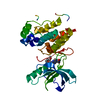


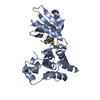
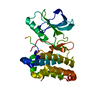
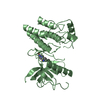


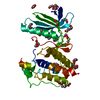
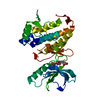
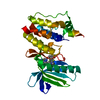


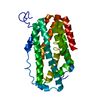
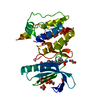
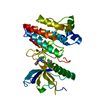


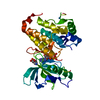
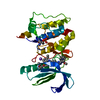
 PDBj
PDBj









